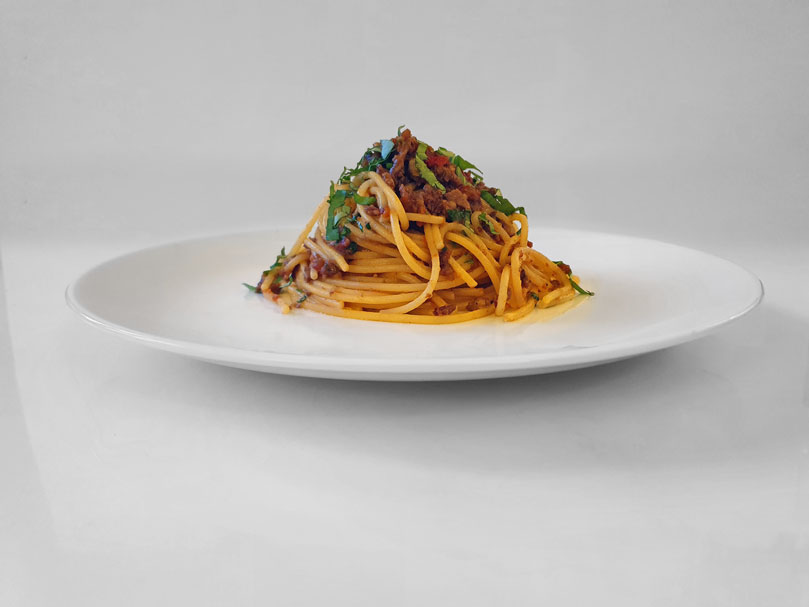
This is the grandstand finish. The final chapter in our culinary journey. My own submission to the bolognese hall of fame!
It’s been an emotional run, but as any great pro will tell you, no one remembers the semi-finalists. If we fail to go all the way, we may as well not have come at all.
For my final dish, I want to capture three things:
First, the past. A nod to the nostalgic. A way to capture the best of what this dish has meant to me and the rest of the population of England over the years, before we got too hung-up on what was authentic or original.
Second, the present. Although not necessarily how most people think of the present. My understanding and attitude towards bolognese has changed as a result of all the research, writing, cooking and tasting I have done to get us to this point, and I want to capture the best of it with this dish.
Third and final, is the future. I want to give my ragù the best possible send off, with as many modern day cooking techniques as is necessary to bring the right balance of flavours, aromas and textures. In order to take my ragù to the next level I’ll be leaning on luminaries with expert opinions.
You will notice from the title that a couple of decisions have been made upfront.
Perhaps controversially, I’ll be using spaghetti. More on that justification soon. I hope less controversially, I’ve decided to name my sauce “ragù all’inglese” (“English-style ragu”). I’ve seen too many others make interesting tweaks to a bolognese, only to be shot down by narrow minded “traditionalists”, usually on dubious grounds of authenticity. The best way to deal with bullies is to take their power away from them. This dish is 100% copyrighted by me, mad-dogs and Englishmen.
It is authentic because I say it is.
The Past
There are some aspects of our Dolmio experience which I am happy to leave in the past.
Most obviously is the cheddar cheese, which is an abomination when sprinkled on a bolognese. End of story.
Good quality mince is another that falls away, although when compared to cheddar I am less vehemently opposed. Mince serves its purpose as a convenience protein, and does taste good. However, good won’t cut it with my ragù all’inglese. I’m holding out for excellent.
After ruling out these first couple of ingredients, and after having a really good think through the remainder of the Dolmio line up, I was surprised with how many ingredients I was willing to rule in.
Tomatoes need to be represented, but not just the deep, umami richness from the concentrates we’ve seen. I also want to somehow capture the tart freshness of chemically enhanced Dolmio tomatoes.
Basil makes the cut. We’ve recognised this ingredient is not remotely Bolognan, but it is a brilliantly aromatic herb and complements tomatoes perfectly.
There are also some additions, over and above what we sampled with our Spag Bol.
I’d mentioned very early on that my palate had developed a love of bolognese topped with chilli flakes, and my position has not changed.
It turns out I am boringly predictable in this regard. Howard Moskowitz, an influential American market researcher, famously led a study into people’s tastes when it came to spaghetti sauce, on behalf of the Prego brand. Rather than there being a single preferred variety, he discovered three categories with which you could contain pretty much all lovers of jarred spaghetti sauces.
There were those who liked it plain, those who liked it chunky and those who liked it spicy.
At the time, there was no market for chunky, which meant ⅓ rd of American consumers would go to bed at night knowing there was something not quite right in their life, but they weren’t able to put their finger on what.
Prego’s chunky tomato sauce filled a massive void and made everyone involved richer in either spirit or cash-money.
As a child, I would have been in the plain-lane, but as my tastebuds matured, I ended up straddling both spicy and chunky.
The ‘spicy’ has been completely missing on this journey, and the ‘chunky’ only stood on the periphery. This needs to be rectified in my final dish.
Finally, for the sauce, I’m also going to include a little garlic.
Italians have a complex relationship with garlic. In some ways, garlic’s story reflects that of tomatoes’. The two ingredients were like lead singers in pub bands, with their brilliance overlooked by the local crowds. Their big breaks came when they travelled to America and their recognition (and association with Italian food) skyrocketed.
However, whereas Italian-Americans were able to grow the popularity of tomatoes in their motherland, the results were patchy for garlic.
Once more, Italian class plays a part. Garlic was a cheap and easy to grow ingredient, which could disguise the worst of a poor man’s diet. These were the same poor men who made a success of emigrating to America, and would eventually influence the non-Italian speaking world’s perception of Italian food.
Meanwhile, back home, the well-to-do continued to navel gaze garlic with suspicion. Mix this with the Italian north-south divide and you discover garlic has (until more recently) seen very little action in a northern Italian kitchen. Danielle Callegari will go into more depth in her upcoming book “Dante’s Gluttons: Food and Society in Medieval Italian Literature”.
We have previously discussed the lesser known tastes which sit beyond sweet, sour, salty and bitter. One such taste is recognised by the Japanese as kokumi. The English translation is the rather unhelpful “heartiness”.
What this means in practice is the rather abstract concept of a strong taste without any taste. Kokumi - when combined with other tasteful ingredients - will magnify the effect of those ingredients, so sweet, sour, salty and bitter are enhanced. Garlic just happens to be the canonical example of kokumi and there is little wonder that it goes so well with a perfectly balanced bolognese sauce.
The conclusion: if tomatoes are to make the cut, then so do its backing singers - basil and garlic.
Spaghetti is the winner!
The announcement comes long before the analysis. It’s a decision grounded in nostalgia, but there is a little more to it.
Massimo Bottura, patron chef of the three Michelin starred restaurant Osteria Francescana, prefers not to serve spaghetti in his restaurant, and makes a notable exception for Spaghetti Cetarese. The details of this garlic and anchovy laden primi piatti are not important for our analysis, but Bottura’s justification for shunning spaghetti is.
Bottura believes his guests will be left underwhelmed by spaghetti as it is so “everyday”.
It is true.
In the home of pasta, people choose to spend their money on spaghetti everyday. They choose to cook spaghetti everyday. They choose to eat spaghetti everyday. It is so everyday because it is so universal. It is universal because it is the best pasta! I understand the arguments for the “perfect pasta for the sauce”, but my eyes will always wander to the perfect pasta.
Being an Englishman, and being shackled to fish and chips, sausage and mash, faggots and gravy, chicken tikka masala and all the other English food stereotypes, means that spaghetti is not so everyday to me. And when I want pasta, I want the best.
The Present
I’ve learned a lot whilst recreating the bolognese story, and my eyes have been opened to new (or old) ways of preparing our favourite ragù. Hats off to l’Accademia, in the end their “official” ragù reigns supreme.
That said, I’m not going to blindly copy their approach, and there are many takeaways I have from their ragù and others we have sampled.
The first and most revelatory discovery was cartello di manzo (aka outside skirt, aka harami). This cut of beef really is the best for a bolognese. Its strong, meaty and mildly gamey qualities provide a country-rustic flavour which I now associate with the dish.
My only criticism of l’Accademia’s use of cartello di manzo is that the taste ended up slightly lost amongst others. The beef was an early addition and as I was building the ragù, I could taste and smell its special powers waning with each new ingredient.
I had purchased a kilo of the meat and had subsequently sampled some in the Japanese style. Marinated in soy sauce and miso and flash fried over a high heat. The taste was incredible, and something I would like to capture in my final dish.
Pancetta was one of the most consistently represented ingredients across centuries of northern Italian ragùs and is definitely required.
The mere inclusion of pancetta is not enough, however. We also have to insist on the mezzaluna minced variety. I bought such a large batch of this cured pork that I’ve had the luxury of trying it in many forms. It is great in large fried lardons in a spaghetti carbonara, but when broken down before cooking you get a much further rendered fat mixed with tiny, slightly crunchy bacony bits. I really appreciated the taste and texture in our ragù alla bolognese, and it is something I want to match.
Another surprise was the combination of tomatoes and butter. Some of you may be surprised at my surprise, but in my previously naive understanding of Italian food I had never considered this simple but effective alchemy.
I think l’Accademia dropped the ball by making the official ragù a toss up between oil and butter. In the French influenced, northern Italian culinary heartland butter rules the roost, and for good reason. It tastes great!
There wasn’t much of interest to me in bolognese’s distant past, save for a couple of considerations.
Artusi’s trick of mixing sauce with parmesan before it hits the table works, adding an ambient, savoury-sharpness to the pasta.
I would also draw special attention to Artusi’s soffritto. I’d previously considered the classic three vegetable combination to be pointless. I would often fry a token onion with my bolognese mince, but didn’t really understand why I was following this ritual.
I’ve really learned to appreciate a good soffritto now. It adds subtly sweet, earthy and herby bulk to a sauce, which is absolutely warranted. The 50:50:50g ratios of l’Accademia’s bolognese soffritto was amongst the best, but Artusi going heavy on the celery has given me something else to consider.
If you recall, the mix of veal, liver and a soffritto with increased herbiness evoked a memory of good quality doner kebab. I believe the additional celery led to this culinary thought bubble, and I wonder if it should be replicated. It is at least worth exploring in more depth. It is possible I was simply craving more herbs across the disappointingly herbless Italian bologneses.
Pork is a tricky one. Pancetta adds so much to a bolognese, but after tasting the pig heavy spaghetti bolognesi I came to the conclusion that my ragù needs to be beefy. I’m still undecided how far I take this but, no doubt, beef will dominate.
One thing spaghetti bolognesi did confirm, however, was that moisture is the enemy of a good ragù.
I’d noticed the “dry”, oily taste of l’Accademia’s ragù before adding milk, but I don’t think I’d twigged this leads to the optimal sugo until I had a second chance to sample such a preparation.
Wine will also make the list, but I am going to consult with some experts before deciding whether this should be red or white.
The Future
Bolognese is so ubiquitous to global cuisine, that almost everyone has an opinion on how to make it. Michelin starred chefs are no exception. I’ve tracked down a list and put their bolognese recipes under the microscope.
This is not intended to be a Michelin starred pissing competition. We’re not always comparing apples with apples. Some examples are clearly aimed at the masses - a bolognese to be enjoyed in front of Netflix, maybe with a slight twist of flavour (or pretentiousness).
Others are at the opposite end of the spectrum. A glimpse into what it takes to keep customers happy at the high end of haute cuisine.
One thing is for sure though, these chefs have more stars than a North Korean general, and should offer some sage advice.
Rather than list the ingredients for each chef, I will point out what I believe to be interesting about their dishes.
Gordon Ramsey (16 Michelin stars)
Ramsey rushes fellow tweakers through a quick “bolognaise” on “Channel 4’s Cook Along Live”. It’s fairly standard fare to the cohorts of the Dolmio generation who decided they had outgrown the jar and wanted to do some real cooking.
Ramsey uses red wine, dried oregano and a touch of Worcestershire sauce. He keeps Italian chefs happy by adding some milk (who am I kidding, no one keeps Italians chefs happy).
Marcus Wareing (1 Michelin star)
Not strictly speaking a bolognese recipe, but the meat sauce for a lasagne in Wareing’s “Wareing at Home” cookbook. Again, nothing too unusual to report other than a touch of cayenne pepper, tomato ketchup and brown sauce. Wareing also opts for Worcestershire sauce, red wine and uses thyme, rosemary and basil at various stages of building the dish.
Marco Pierre White (5 Michelin stars)
Described as an “easy bolognese”, White offers another fairly down-the-line anglicised bolognese sauce.
Garlic is included, along with bay leaf, thyme and his “secret ingredient” - the Knorr stock pots he gets paid to promote. His soffritto is cut very fine and looks similar to the mezzaluna-mashed version we’ve seen across the genuine Italian recipes.
White has also gone on record advising the addition of chocolate and chili to a bolognese sauce, though presumably never in front of the Italian side of his family.
Tom Kerridge (3 Michelin stars)
The publican and jolly Michelin starred chef-next-door ups the pace when he serves his spaghetti bolognese to Michael Parkinson, on behalf of Waitrose’s “Parky’s Top Table”.
Kerridge is a self confessed mince lover, and brings some interesting techniques to his bolognese. We’re told to roast the mince in the oven until it dries out and resembles something like coffee granules. Kerridge is looking for the “depth of flavour” of dried and browned mince.
Most interestingly, Kerridge oven bakes caster sugar covered tomatoes and suggests finishing them with a blowtorch to char them slightly.
It’s all very rich and flavoursome, and Kerridge balances it out with a very healthy chug of red wine vinegar, and allows the mulch to thicken before adding the coffee-granulated beef, blowtorched tomatoes and mushrooms.
It’s herby. Dried oregano, fresh oregano, bay leaves and sage accompany star anise, clove and black pepper.
Sat Bains (2 Michelin stars)
Starting to sound like “this is how I’d do it in my own restaurant” advice, Sat Bains doesn’t exactly offer a recipe, more guides us as if he were the bolognese Yoda.
In an interview with the Daily Mail, he explains how most of us are getting bolognese wrong.
You can’t make a bolognese quickly. Each layer of the dish needs to be built up, piece by piece, with every last ingredient cooked until it can offer no further moisture.
If the occasional slice of onion catches and ends on the wrong side of caramelised, so be it. The onion made a worthy sacrifice to a sauce pushed to the edge of dryness in the pursuit of a deep flavour.
Bains starts with the meat, then goes through the gears with veg, stock, tomatoes and herbs (though doesn’t mention which ones), and promises a deep flavoured ragù.
Heston Blumenthal (6 Michelin stars)
The mad scientist of haute cuisine goes balls deep on bolognese in his BBC series “In Search of Perfection”. His mission is to take the spaghetti bolognese he remembers as a child and stretch it to new bounds, without it being rejected by English spag bol protagonists.
For an amateur cook, his recipe is intimidating. Blumenthal bones and minces oxtail, adds pork shoulder and builds a rich sauce base with the addition of a soffitto, oaked chardonnay and whole milk. The meat flavours are accentuated with star anise.
The yang to this meaty ying comes from a tomato compote, which resembles a 16 year old boy rifling through his parents drinks cabinet and concocting a witches’ brew. However, rather than the end goal being drunken obliteration and bedwetting, the apothecarists’ aim is to create a sharp, umami, face-slapping hit of tomatoeiness to balance the deep sauce base.
The compote contains tomatoes, garlic, coriander seeds, star anise, cloves, Tabasco, Thai fish sauce, Worcester Sauce, Tomato Ketchup and Sherry Vinegar. It’s combined with the meat base, but when eaten alone it’s like rubbing battery acid into your gums and attaching electrodes to your nipples.
Massimo Bottura (3 Michelin stars)
Bottura is the master of pulling his compatriots out of their comfort zones with his unique take on Italian cuisine.
Initially cold on the idea of serving tagliatelle al ragù in his three Michelin starred restaurant, Bottura was persuaded to take our favourite dish to dizzying new heights. He provides a glimpse of what it takes to be named the world’s favourite restaurant in his 2014 book “Vieni in Italia con me” (“Come to Italy with me”, retitled “Never Trust a Skinny Italian Chef” for English speaking audiences).
The ragù is extremely rich and meaty. Beef cheeks, veal tail and veal tongue are first browned before being cooked sous vide at 63 degrees for 24 hours. Each batch of meat is then finely sliced and combined with a soffritto, tomato confit, white wine, bone marrow, pancetta and sausage meat.
I’ve read an interview where Bottura announces tomatoes are used to hide a bad ragù, but seems to make an exception for his book. His confit is described in another recipe and consists of Piennolo cherry tomatoes, garlic, thyme, olive oil, red pepper oil, sugar and salt. As well as the thyme, Bottura also introduces dried bay leaves and a sprig of rosemary to the finished ensemble.
Bottura’s tagliatelle starts off as a fairly standard flour and egg mix, but with an increased egg yolk content. To his pasta dough, he also adds the juice from 8 “embryonic eggs”.
Embryonic eggs are often known by their Filipino name “balut” and contain a tiny chicken embryo and juice from a metamorphosed egg yolk. The juice apparently tastes like a mildly chicken stock flavoured yolk.
Bottura subscribes to the notion that moisture is the enemy of a good ragù, but takes this to a new level with his pasta preparation.
Similar to Alvisi, he par-cooks his tagliatelle in stock, opting for litres of decadent caponne brodo. He then transfers the par-cooked pasta to the ragù for the final few minutes of cooking. Presumably, Bottura has learnt to time the ragù and pasta preparation to perfection, and the final drops of ragù moisture are exactly enough to hydrate an al dente tagliatelle.
Parmesan does not belong on a Bottura ragù, as it changes the taste, so don’t ask for any if you ever experience the pleasure of dining at his restaurant.
Tips from the top
I first made Blumenthal’s bolognese years ago, so I am well acquainted with the method. If you ignore the advice to bone and mince oxtail, and take the odd shortcut here and there, it isn’t such an arduous affair.
I can save you the embarrassment of asking your butcher to mince oxtail for you. It is apparently an old butcher’s joke, saved for the first day an apprentice arrives. Like asking a young builder to go to a hardware store and pick up a tin of “elbow grease” or “tartan coloured paint”.
Bottura is interviewed in Blumenthal’s Search for Perfection, and clearly influences the Englishman’s bolognese recipe. Blumenthal limits the “stewing cuts” of meat to oxtail, but I suspect he would have gone further if he wasn’t trying to stay on the right side of the bolognese memories of his audience.
After first tasting a bolognese with oxtail, I was hooked and went looking for ever richer ragùs. I have used oxtail, beef cheek, beef shin and bone marrow, and with each additional hard working cut, it is harder to go back to the beef mince bolognese of yesteryear.
After a while I would stop including tomatoes. The reason was more pragmatic than gastronomic. I’d be making such enormous batches that tomatoes felt like a waste of freezer space, and something that could be added at a later stage if required. Although it often wasn’t.
Heston mixes his tomato compote into the ragù at the end of cooking so that it is fully dispersed and all the weirdness of a bolognese having Thai fish sauce and other household condiments is balanced.
I have experimented with serving the two components separately, with the compote as a finishing sauce. It makes for a tasty and interesting alternative, although the compote could really do with being toned down when following this path. It is epically pungent!
It feels to me like following the thought process of the last two chefs actually means making decisions on two dishes. The first dish concerns the preparation of a rich and meaty ragù base. The second dish is the acidic counterpart, the tomato based compote, which can complement the first.
For my ragù base, it’s going to be a difficult decision of what meat to use. Going all in on Bottura’s ingredients is tempting but feels like it overlooks the bolognese journey we’ve been on. It took me this long to find the incredible cartello di manzo cow diaphragm. I don’t feel it is now appropriate to overlook my new found knowledge.
My tomato compote feels like a slightly easier decision. I don’t want a Blumenthal style concoction that only works when combined with the meaty ragù base, I would like this component to be a tasty dish all on its own. This probably leads to something similar to the tart fruity taste of our spag bol, but on the right side of sharpness.
This isn’t going to be a dish I can just cook blindly. I’m first going to have to do a little bit of experimentation to find my ideal taste.
In the Lab
There’s a few elements of the dish I’m fairly clear on. My ragù meat base just needs to be as meaty as I can make it, and a long slow cook in Bottura’s style should see me right. However, some of the other elements I’m less sure about. I’ve run a series of experiments on these individual components to make sure I’m well placed when it comes to execution time.
Tomato Compote
I want my tomato compote to be tomatoey, but not just the umami hit of tomatoes from a concentrate or passata, I also want the sweet tang of a good Dolmio and there must be chunks!
In the same cookbook as his spaghetti bolognese, Blumenthal also has a recipe for margarita pizza. His tomato topping brings some interesting techniques and I adapt these to my own kitchen.
We start by peeling the skin off a kilo of fresh vine tomatoes, removing the seeds and halving. Preserve the vines as we’ll be using them later. Half the tomato segments are put into a dehydrator and dried to the point where they have a dark red colour but without being as dry as sun dried tomatoes. The other half are placed in a pressure cooker with all the tomato seeds and any leftover juices.
The pressure cooker is used to squeeze out all the flavour from the seeds, which contain a high concentration of that tomato umami. Once the pressure cooked tomatoes have cooled, pass the juice through a sieve and refrigerate in a plastic bag with the tomato vines.
After 6-12 hours in a dehydrator (depending on the ripeness of the tomatoes) the segments should be transferred to a small jar and preserved in oil. We need to give the tomato juice and vine combination at least a night to percolate, after which time the tomato sauce can be combined with the tomato chunks and the stalks discarded.
The resultant sauce is rich, but is potentially a little too rich. It lacks that sharp and fresh taste of our Dolmio sauce. I decided to add some ingredients which I hope will take it in the right direction.
I’m not yet sure what meat my compote will be mixed with, but it seems chicken livers will form the basis for a cheap and reasonably realistic experiment. I finely slice the livers and fry in a decent block of butter before adding garlic and the tomato sauce. The ingredients which I think may help achieve what I’m aiming for are citric acid and anchovies. This leaves me with the following experiments:
- The control - the mix as described above. Tomato sauce, chicken livers, garlic and butter.
- With anchovies - the control, but with 2 fillets of finely sliced anchovies added as the garlic fries.
- With citric acid - the control, but with a small sprinkle of citric acid dispersed throughout the sauce.
- With anchovies and citric acid - a combination of both the anchovy and citric acid versions of the sample.
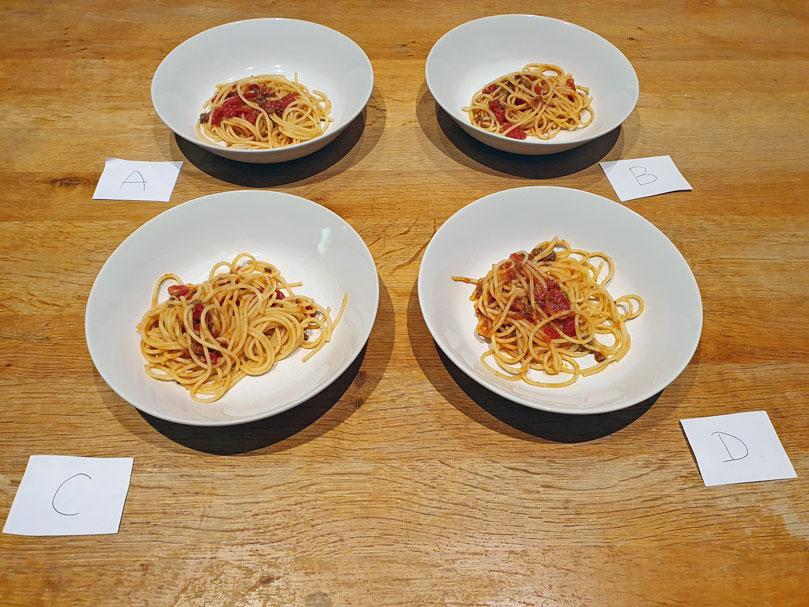
The control was edible, but the hit of tomatoes was a little overpowering for a spaghetti sauce. It was similar to pouring Heinz Tomato Ketchup over your spaghetti. At this level of concentration, the flavour was so deep and sweet, it had more of a place on a burger than on pasta.
The anchovy version was again edible, but the freshness of the anchovies couldn’t overcome the richness of the tomato. I was happy that the mix of chicken livers and anchovies wasn’t a complete failure. Although this might be the perfect mix for a pizza topping, I don’t think it is the right flavour for my ragù.
With added citric acid, we’re starting to get some balance. The sauce is delicious, but somehow tastes a little “normal”. It is like a richer more decadent tasting version of our homemade Dolmio.
Without a doubt the best flavour comes from the combination of citric acid and anchovies.
The tomatoes and citric acid combine to give the instant Dolmio-like hit but then the long notes of freshness come from the anchovies. If I was to critically assess this experiment, the long notes were a little too long and a salty fishy taste overpowered the tomatoes and livers after a few seconds. For the finished dish I will have to tone this down, but on balance this test can be declared a success.
Cartello di Manzo
On to the cartello di manzo, and this has to be the element of the dish in which I’m most intrigued. Our bologneses so far have all allowed this meat to melt away in the real ragù style, and although the beef has been an excellent team player, it is now time to see if it can perform a convincing solo.
If you cast your mind back, the Japanese consider harami a delicacy and will marinade the meat in soy sauce and miso. These are strong, punchy flavours which wouldn’t be used for a more delicate flavour of meat. I have a couple of questions in the back of my mind.
First of all, does this meat need the marinade? I want to test a sample with just a little salt to understand if the meat stands up on its own.
Second, can I play on the Englishness of this dish and swap in my own punchy marinade? I don’t want my ragù to taste like soy sauce and miso. If this combination gives the best flavour, so be it, but i would rather bring out English flavours if possible.
After listing out the strongest English flavours I know, I settle on a combination of London porter, Marmite from Burton on Trent and Cornish dulse seaweed.
It’s a pungent mix!
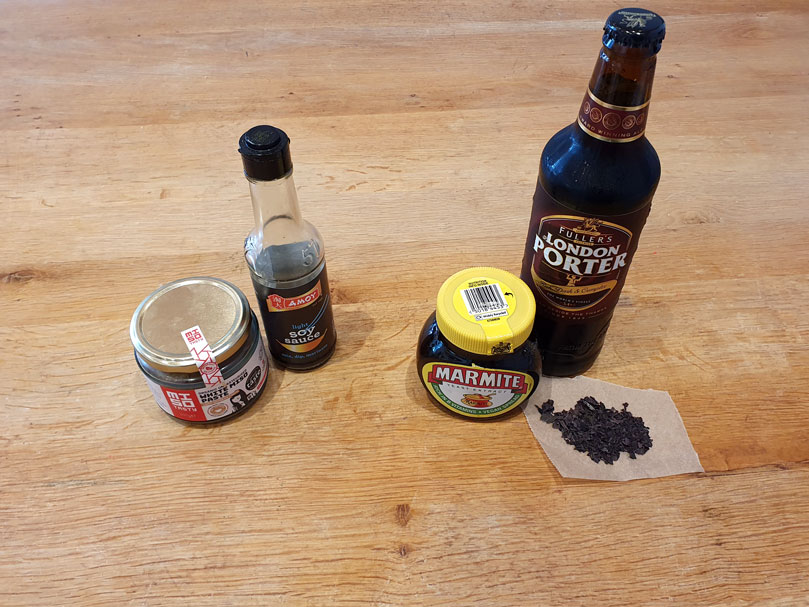
The control meat, and the Japanese and the English versions are all separately bagged and given two hours in the sous vide at 54 degrees. After the hot bath treatment, each piece is laid out on a cake rack and blasted with a welder’s blowtorch until it is slightly blackened.
I’m trying to replicate the Japanese yakiniku barbeque experience which seems like a sensible way to cook this meat. Tender streaks of meat and fat on the inside with a sporadically crisp, charred, marinade infused outer layer.
You need a proper blowtorch to accomplish this aim, the small creme brulee ones don’t pack enough heat to work across all this meat.
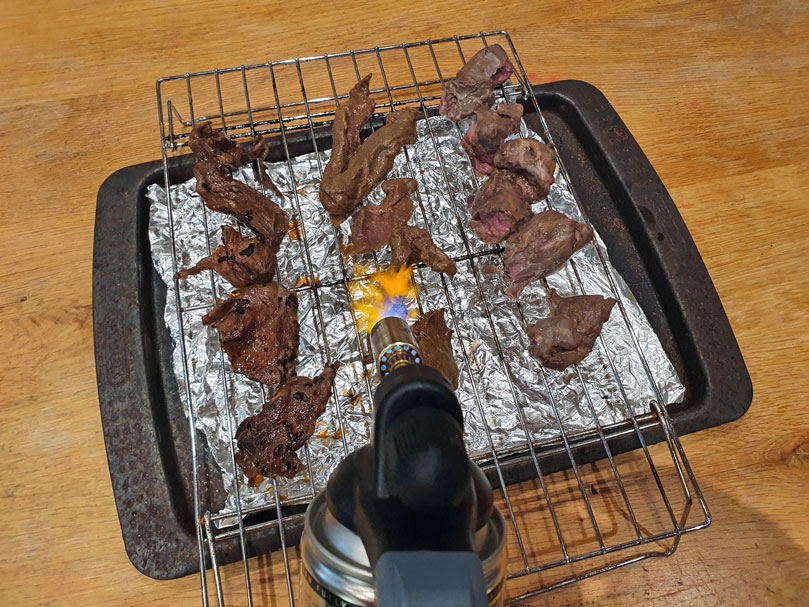
Once the meat is plated I’m able to cast judgement. I try the control first.
This is a “challenging” meat. Think of an overcooked steak on the BBQ, possibly rump, with a big side of fat. Imagine taking the full length of fat and placing the whole thing into your mouth and chewing and chewing until it was ready to swallow down. Each chew releases more of a greasy, meaty flavour into your mouth, along with a strong charred taste.
This is a similar taste to a blowtorched piece of sous vide cartello di manzo, however, there is a big difference. Rather than the unpleasant texture of chewy meat fat, the slow cook has made this completely tender and the meat offers no resistance. It feels very different to how it tastes. The control is good, but the flavour is intense and there is nowhere for the intensity to hide.
I next try the English marinated meat. My first mouthful brings an overwhelming hit of burnt marmite. Oops. The marmite hasn’t dispersed very well and the first taste was a chunk that had taken the blowtorch treatment head on. This bite feels like a failure.
The Japanese soy and miso marinated meat offers a big flavour, but you can see why these are considered a delicacy in Japan. It’s a flavour full of funk and the big hit from the marinade stands up to the fatty, gamey taste of the meat. The problem is, this flavour is very clearly Japanese.
I go back to the English and slice from a different area. This time it’s much better. The musty, rich and dark flavour of the porter, dulse and marmite mix is more subtle than the previous burnt marmite disaster. It couldn’t taste more English. It’s like getting a whiff of roast beef cooking in the kitchen of an old man’s pub, while the waft of the beer drip trays add to the “ambience” of the place.
I start going back and forth between the different cuts of meat. After a while, I’m convinced that the cartello di manzo needs something.
The control gets harder to eat with each mouthful, however, both the marinades complement the meat like a strong, fatty lamb against a bold red wine with strong tannins.
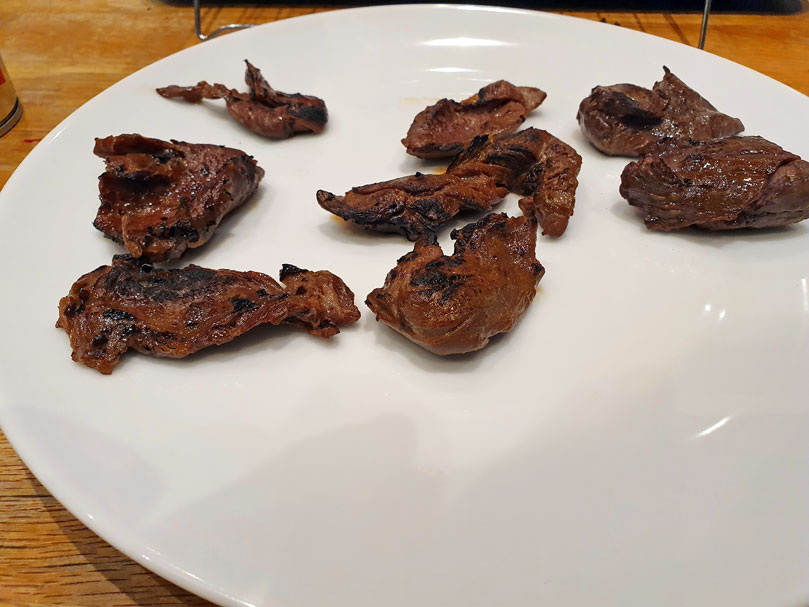
It takes a while for my taste buds to settle. Picking a favourite is hard. It’s like being asked what my favourite shower gel is, but being asked to conduct the test in a shower a couple of degrees above freezing.
I conclude the English will do a perfectly good job and has more of a “ragù” about it. The Japanese marinade made a powerful statement but tasted too Japanese.
It may seem strange with the adjectives I have used. Funky. Musty. Gamey. Challenging. But remember this is a component part of a much larger whole. Sitting down for a nice Thai meal doesn’t start with every person at the table drinking a pint of fish sauce.
The flavours here are an enhancer, which can be eaten, and just about enjoyed, on their own. Though will add to the depth of flavour of our ragù.
Pasta
I’ve already decided spaghetti is my pasta of choice, but choosing the ingredients involves a little bit more than you might expect.
Up to this point we’ve been working to a fairly standard recipe: 1 egg per 100g of flour and maybe a bit of salt. We swapped out plain white tipo 00 flour for semolina for Artusi’s bolognese, but this can’t be considered an adventurous step. Pasta has a lot more avenues to explore.
The levers at our disposal are quite varied, and the permutations make the perfect pasta an interesting proposition. We can change the number of eggs, but it’s not just the quantity, we also need to decide on the ratio of egg white to egg yolk.
Flour is either white tipo 00 or semolina, but you can blend the two. Olive oil can be added. Salt too. There’s also no end of ingredients that add colour and flavour.
Finding the perfect mix doesn’t have to be guess work. There’s a fair bit of science that can help craft the perfect pasta for any situation. The protein and carb mix can be calculated up front and balanced for plasticity or elasticity. Marc Vetri’s book “Mastering Pasta” is one of the best I’ve read on the subject and describes in detail how to match the pasta dough to the pasta to the sauce.
I try a few combinations on my way to picking my pasta. Pasta dough recipes were not a specialist subject of mine, so this experiment had some interesting twists and turns.
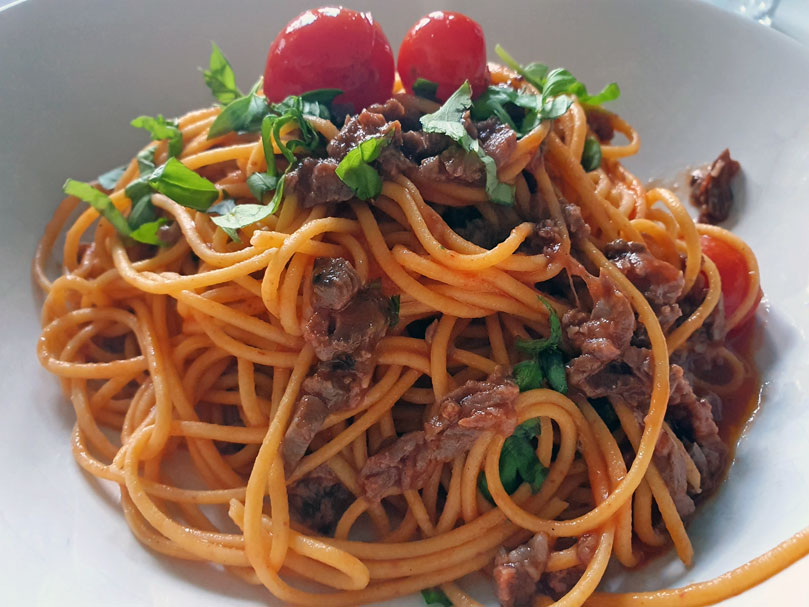
I want to introduce some spice to the dish, and decided adding the spice to the pasta could be a plausible way of delivering an ambient heat which will work well with my meaty sauce base and compote. I initially think it might be interesting to combine a hot and smoky spice mix to my dough.
I have a selection of dried chilis:
- Kashmiri - probably the best tasting chilli there is.
- Smoked Paprika - to add depth of flavour.
- Cayenne - a great allrounder.
- Bhut Jolokia (aka Ghost Chilli) - amongst the hottest out there.
I understand enough about the Ghost Chili to know it needs to be treated with respect. I’ve occasionally tasted it’s cousin Naga and even though this has a lower scoville count, it can blow your head off. I tentatively place one whole Ghost Chilli in a spice grinder. The smell is quite unique, it has an aroma reminiscent of raspberries or blackberries, but somehow more mischievous. Into the spice grinder I also place three Kashmiri chillies and blend to a fine powder.
Taking the lid off the grinder produces a hit of chilli heat at the back of my nose which I don’t feel like I deserve, like being pepper sprayed for littering by an overzealous police officer. I water this mix down further with a good scoop of Smoked Paprika and Cayenne.
Meanwhile, I prepare my pasta dough and I’m going all out deluxe. A dough rich in egg yolk gives an eggy and decadent taste. Jamie Oliver calls his equivalent the Royal Pasta Dough.
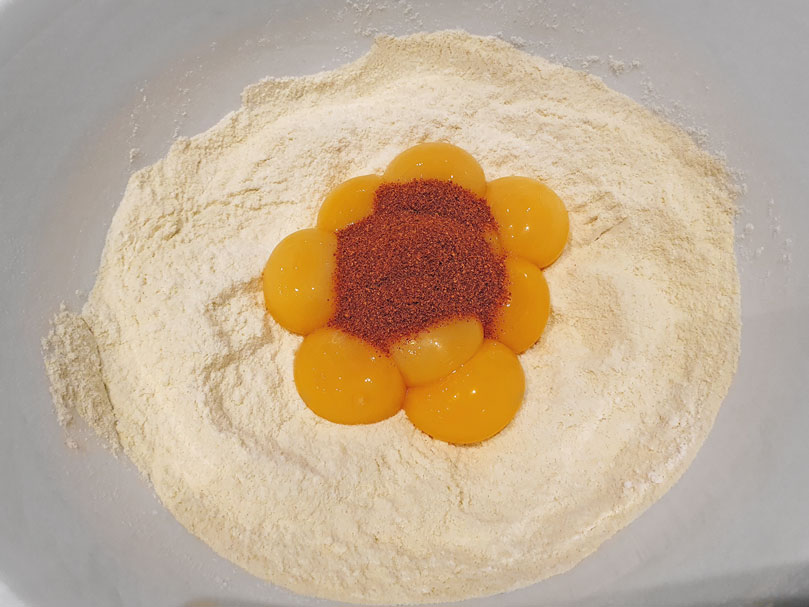
I’m following some of Vetri’s advice, because every gram of chilli replaces a gram of flour, you need to consider the change to the mix of protein and carbohydrate. Chilli is low in protein and high in carbohydrate, so my flour balance is heavily slanted towards the semolina to get the protein levels back up.
As usual, the dough is mixed, kneaded, refrigerated and rolled. This time I use my pasta machine spaghetti attachment and am ready to taste it fresh.
I have to say, the results are a little disappointing. I try the spaghetti with a simple bolognese of leftover cartello di manzo mixed with tinned tomatoes. After the Ghost Chilli is progressively watered down with other chillies, pasta dough and eventually bolognese, there’s not much spice left. I also notice that the pasta becomes quite crumbly as it dries very quickly.
Back to the drawing board.
My second attempt is a calibration in the opposite direction. This time I go for two Kashmiri chilies for every one Ghost Chilli which is added to a dough with additional egg white. Following the same procedure as before I combine with a simple bolognese and taste again.
This time I can taste the chilli. When combined with the sauce it isn’t that strong, but chewing down on plain pasta I get quite a decent kick from the Ghost Chilli. After finishing the bowl I give myself a night to sleep on this pasta and consider its potential for stardom in my final dish.
At 5am I’m rudely awoken by a mild pain in my abdomen. It turns out I have successfully developed a recipe for spicy spaghetti where the chilli heat bypasses my mouth and is delivered directly to my colon.
The time spent on the toilet that day gives me plenty of opportunity to contemplate my pasta consumption technique.
When mixed with bolognese, I don’t think I spend a great deal of effort chewing spaghetti. I definitely chew the ragù but can consider the pasta to be collateral damage. Spaghetti with a light sauce could almost be inhaled.
I decided to try one last spicy pasta mix.
This one is a little more complicated. I’m trying to encourage all the spice to the outside of my pasta sheets so that the resultant spaghetti is spicy on the outside only. I prepare a similar pasta mix, but this time without the spice. I start rolling a thick dough and slice a 30cm portion off, I then cover this in the Ghost Chilli and Kashmiri Chilli mix, before folding the dough over the chilli. This portion is rolled from the number 3 setting on my pasta machine, all the way down to number 9 (as thin as it goes).
With each roll the sheet gets longer, and more chilli can be seen just about breaching the surface of the dough. It actually looks quite unhealthy, like eczema skin, or the nose of an old alcoholic.
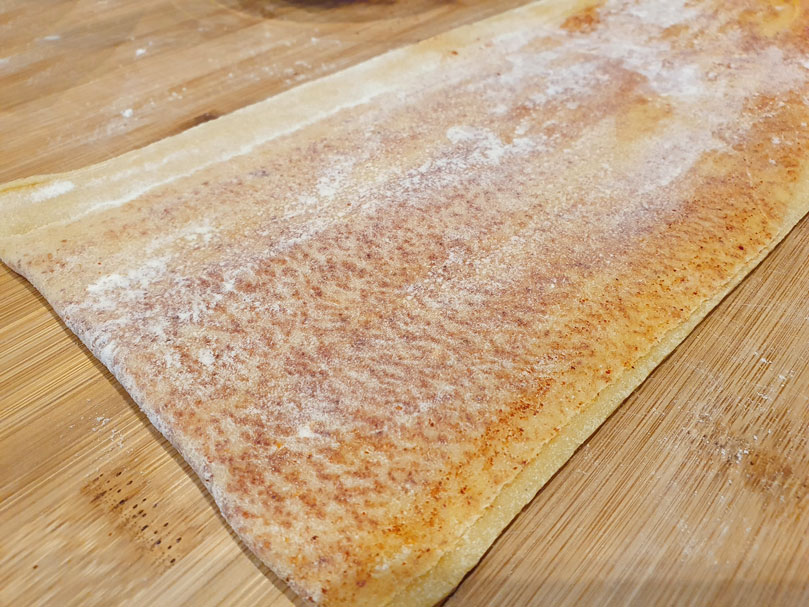
Once I have a long thin sheet of chilli pasta dough and a thicker sheet of normal pasta dough, I’m combine the sheets by splashing with a little water and pressing the two components together, before giving them a final couple of rolls in the pasta machine, to get the combined sheet to the number 4 setting.
This is finally passed through the spaghetti attachment and the strands are hung up to dry slightly.
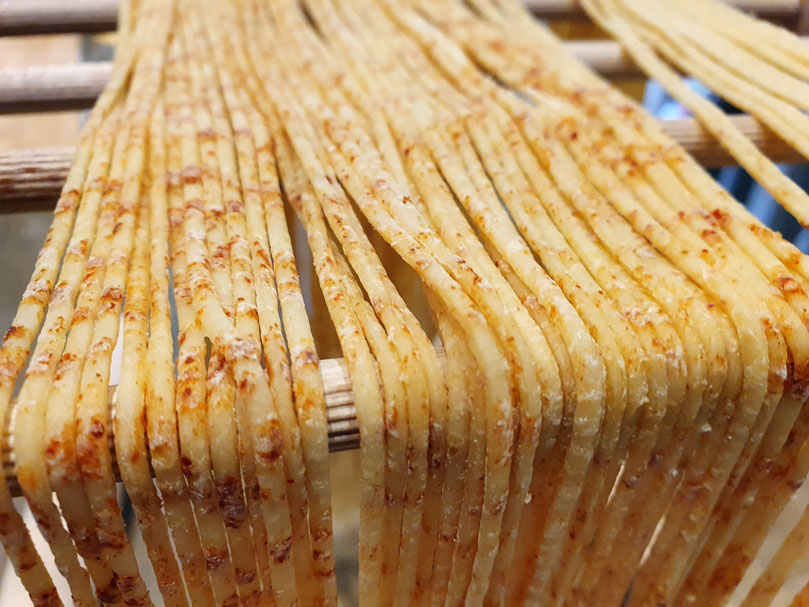
Unfortunately the situation has not significantly improved. If you really bite down on the pasta, you can taste the spice, but when served with a ragù, I’m back to the spaghetti inhalation habit.
My conclusion is that chilli spaghetti is just not meant to be.
At least I did learn a few things throughout this process. The decadent egg yolk pasta dough works perfectly for soft strands of tagliatelle or pappardelle, but for spaghetti you need a finished pasta you can get your teeth into. It is for this reason I settle on a simple dough rich in semolina flour and egg.
As for the spice, I abandon any attempt to deliver this directly with pasta, so need to think of an alternative form of delivery.
Herbs
One of the hardest things to wrap my head around whilst creating all these bologneses is the Italian aversion to herbs. Nothing makes it in through the front door.
I’m encouraged by Bottura’s position. He’s not sprinkling basil over his ragù, but he does make space for some obvious pairings in his preparation.
Thyme with garlic and tomatoes is an open goal. Bay leaves and rosemary with slow cooked stewing cuts is another that needs no justification. You can imagine how hard a time he has getting Italians out of their culinary comfort zones if such herbs are considered controversial.
I’ve decided the liberal use of herbs is one area which will separate my ragù all’inglese from a bolognese. From Bottura’s herb list, thyme and bay leaves are probably my top two. What I now need to understand is what else could be added.

I’ve already committed to basil, and feel it’s appropriate to pair the bay leaves with my meat base and the thyme with my tomato compote. Deciding beyond these base herbs will need some experimentation. I’ve shortlisted sage and coriander.
Sage has an aromatic flavour, reminiscent of a damp forest. It’s most famous alongside fatty or gamey meats, so should be a good match for my cartello di manzo, which means I will be testing it against my tomato compote. The only question is whether the compote needs it. With my meat marinade, tomatoes and garlic I’ve already got a lot of competing flavours. The woodiness could be a subtle note that stands to the side of the other flavours and this is what needs to be understood.
I’ll be using some of the basic bolognese of cartello di manzo and tomatoes I previously used to test my spicy spaghetti.
Coriander may seem like a weird choice, but remember I’m trying to build something unique and occasionally I deliberately want to break down the Italianness of this dish. As far as I can see, coriander has absolutely no place in Italian cuisine. It does apparently grow wild in southern Italy, and you can normally rely on poor southern Italians to bring these “obscure” flavours to our attention via their American sounding board. However, this does not appear to be the case. Coriander is not too prevalent across the Mediterranean, Portugal being the notable exception.

The English were exposed to this delicious herb through Indian cookery. Coriander brings a flavour which is a cross between parsley and fresh citrus which means it is excellent as partial relief from a rich and spicy lamb curry. As the country later adopted an increasingly Mexican taste, coriander has cemented its place as one of our favourite herbs (well, mine at least).
I’ll be testing the herb against my ragù meat base and there are two things I want to understand. If I add this to a rich meat sauce, which I know will also be spicy, will it make my ragù taste too much like a curry? If it does start to taste like a curry, is this such a bad thing anyway?
Fortunately I am able to produce a portion from the aforementioned stock of oxtail and beef cheek ragù in my freezer, preserved prior to the addition of any tomato products. I will be able to add a little chili and sample a rich and meaty ragù with and without coriander and sage.
With the sage, my suspicions are confirmed. From an admittedly generous helping I can taste what feels like too much of an earthy flavour for the tomato that’s about to drop. It’s by no means a failure - it tastes delicious but sends the dish in a direction I have a feeling I wouldn’t want it to go.
Next comes the corriander. This taste is exactly what I’m looking for! The mildly citrusy finish is a micro calibration towards the perfect balance. Still intensly meaty but with a suggestion there’s a little more on offer, like the slight hint of smugness in the mouth of an otherwise po-faced Mona Lisa.
The spice and corriander mix presents no weird association with curry either, and I gladly declare this spice and herb mix to be a success.
Wine
I can’t easily test for the best choice of wine, seeing as it is such a core component of the ragù. Testing would mean making the full dish end to end and comparing the outputs with different wine as part of the ragù meat base. However, it is worth examining in more detail.
We’ve already discussed how in recent history l’Accademia inexplicably switched their wine preference from white to red. You’ll see most of our British Michelin starred chefs recommend red wine, but both Bottura and Blumenthal opt for white.
From my culinary preconceptions, red seems to be the logical choice. Red wines contain far more tannins than white. This is because red wines are made with at least some of the skin of grape, which is where these molecules are most concentrated. When cooked in a ragù, the tannins will break down, but not as quickly as the sauce will reduce. The result will be more concentrated tannin content.

You might think this would increase the tannin taste, which for those less familiar with wine, means astringency - which gives a dry feeling in the mouth. It’s not quite as simple as this though. Tannins are drawn to protein strands and in combination will lose their astringent taste.
Sommeliers sometimes play on this chemistry and will serve a tannin rich red with a juicy steak. The tannins might otherwise be too strong for casual drinking, as each gulp of wine gives that dry mouth flavour. The diner unwittingly seeks refuge in their next mouthful of steak and once the tannins from the wine and protein from the meat combine, the dry taste is broken down making way for the juice from the beef. This beef might otherwise have seemed juicy, but from a starting point of having a dry mouth, that juice flavour is accentuated and the mind is tricked into thinking this was a particularly juicy cut.
In a slow cooked ragù the chemical effect will have played out long before your first mouthful, but it does leave something behind. The tannin and protein mix will create a stickiness within the sauce which adds to similar properties of the gelatins and fats and will make the sauce taste “more meaty”.
This property is why the general rule of thumb is to use red wine when cooking with dark meats and white wine when cooking with poultry and fish.
On the face of it then, the logical choice appears to be a ragù of red wine, but there’s still more to consider. Most importantly acidity.
We’ve touched on this already. Good flavour is about balance and the basic levers are fat, salt and acid. Our ragù is going to be rich and with a high degree of fat. It’s going to need acidy to cut through that fat, and one place it could come from is white wine.
Both red and white wines are acidic. Acidity is measured on the pH scale with 7 being neutral and the lower numbers meaning something is more acidic. Red wine falls in the pH range of 3.3 to 3.6, while white will be 3.0 to 3.4. It may not sound like a huge differential but the pH scale is logarithmic, so 4 is ten times less acidic than 3.
The acidity of wines will vary significantly and generally speaking, wines from cooler climates will be more acidic. If our ragù is light on the acidic tones it could lack balance, so maybe the more obvious choice is actually white.

This tour through A level chemistry is all very interesting, but overlooks another property the wine brings.
Flavour!
Our choice of wine is going to contribute aromatics which will influence the dish, so it may be better to overlook all of the science and choose a wine, of any colour, which brings out the best overall flavour.
We don’t appear to be any closer to picking our wine, so maybe it’s worth examining what Bottura and Blumenthal’s thought process is.
Bottura offers no justification for his white, but looking through his ingredient list, his ragù seems to be in serious need of acidity. A top chef like Bottura would be acutely aware of the balance required to earn Michelin stars and I will hazard a guess he’s gone for a crisp, acidic white in order to introduce as much acidity as possible.
Blumenthal’s book is specific and requests we choose an oaked chardonnay. He also explains why, suggesting this is the perfect accompaniment to the sherry vinegar. Interestingly, he makes no reference to acidity (interesting because he mentions acidity on a very regular basis throughout his books). I assume he’s decided his compote will make his spaghetti bolognese tart enough, so he’s left to focus on flavour.
I decide my ragù meat base is likely to be most like Bottura’s, and if white is good enough for him, then it is good enough for me.
Who knows, 20 years from now I might inexplicably change the content of this recipe and switch to red, in l’Accademia style.
Dolmio sherbet
Dolmio sherbet, WTF?? You may be thinking.
This became a bit of an obsession as I was deciding on the ingredients for my spaghetti al ragù all’inglese.
Dolmio is loaded with sugar and citric acid. Could I play on this combination and reduce the taste down to something resembling sherbet? I thought it was worth a try - a little bit of garnish on the plate to excite my diners.
Sherbert is a simple recipe of a teaspoon of citric acid, a teaspoon of bicarbonate of soda and 50g icing sugar. You can add a little of something equally tart, like freeze dried raspberries, and you have yourself a flavoured sherbet. I had hope that the same could be done with a powder of dehydrated tomato.
Unfortunately it didn’t quite work out. Like the freeze dried raspberries, tomato is sweet, but also contains the umami hit of savoriness. The mix of sherbet and tomato just didn’t work. I couldn’t balance the flavours. I tried a number of approaches - dehydrating the flesh, the seed and the skins. The skins probably gave the best outcome, but only because they have the least flavour and so allowed the sherbet to take over.
I was at a dead-end, but by now you should know how we bridge the gap between sweet and tart.
Using fat of course!
My next experiment was a much greater success. First I needed a source of fat, and opted for everyone’s favourite Dolmio bed fellow - mince. The mince I went for was the real fatty stuff. I chose a mince with a 20% fat content and cooked this over a high heat until the meat was starting to go from brown to black. The meat was literally swimming in fat, so it took a while for the colour deepen. The fat was drained into a small pot and the mince used for other purposes.
The next step was to mix a small amount of the fat with tapioca maltodextrin. This ingredient is in the bracket of entry-level molecular gastronomy. It is an incredibly absorbent substance that will soak up any moisture or fat it comes into contact with. Mixed, by weight, with an equal proportion of fat, tapioca maltodextrin will “dehydrate” the fat and turn it first into a paste, then into a powder.
What this means in practice is the fat being suspended within the powder. Still maintaining whatever taste it came to the party with, but with the addition of a mild, almost undetectable sweetness.
An important application of this alchemy is that fat and tapioca maltodextrin should be mixed in equal parts by weight, and not by volume. This incredible substance is so unbelievably light, it appears to defy the laws of the natural world, so you need a lot of it to equal the weight of the fat.
The mix of beef fat, tapioca maltodextrin and pre-prepared tomato sherbet works wonders, but tastes nothing like the sweet tang I was aiming for. However, it is quite a convincing Dolmio bolognese powder.
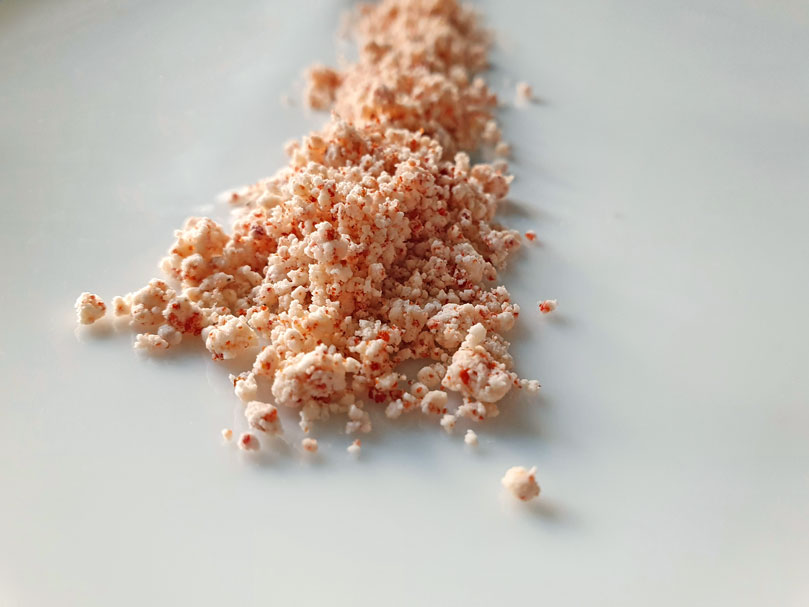
After jettisoning the sherbet and instead mixing beef fat, tomato powder, tapioca maltodextrin and everyone’s favourite dolmio additive - citric acid, I’m left with an even more realistic taste of our all time family favourite.
It’s all very cool, but not remotely likely to grace the plates of my diners as a garnish to spaghetti al ragù all’inglese. I conclude that dolmio sherbet is a dead-end and throw in the towel.
With this decision made, I also draw to a close my taste experiments.
Spaghetti al ragù all’inglese
As this is my own creation there is little point in displaying a recipe and speculating on the taste. I will save my critique for the tasting notes. However, there is still some further analysis we can perform, which should provide some context to spaghetti al ragù all’inglese.
So first the ingredients I settled on:
Spaghetti al ragù all’inglese
Pork Brodo
- 1.35kg Pork Rack of Loin Ribs
- 250g Celery (3 full stalks)
- 400g Onion (2 large)
- 350g Carrot (3 large)
- 4 cloves Garlic
- Salt to Taste
- Water (to 2.5 litres with other ingredients)
Meat Base (for about 2.2kg)
- 1.1 kg Oxtail (8 medium to large sections)
- 850g Ox cheek (2 cheeks)
- 750g Rolled Beef Shin, bone removed
- 750g Bone Marrow (6 rounds)
- 350g (Reduced by Half) Pork Brodo
- 250 g Lardo
- 390g Celery (6 full stalks)
- 550g Onion (3 large)
- 650g Carrot (6 large)
- 500ml Mud House Sauvignon Blanc White Wine
- 10 Bay Leaves
- 3 Sprigs Rosemary
Marinated Harami
- 200g Harami (Cartello di Manzo/Outside Skirt)
- 250ml Fuller’s London Porter
- 1 teaspoon Marmite
- 1 teaspoon Dried Cornish Dulse Seaweed Flakes
- 1 teaspoon Demerara Brown Sugar (+ more to sprinkle)
- 1 teaspoon Salt
Dehydrated Chopped Tomatoes
- 1.8kg Sainsbury Jubilee Tomatoes
- 3 cloves Garlic
- 1 sprig Rosemary
- 2 stalks Thyme
- Olive Oil (to preserve)
- Salt
Tomato Compote (for about 1 kg)
- Flesh from 900g Dehydrated Chopped Tomato
- 300ml Dehydrated Tomato Juice
- 150g Pancetta
- 75g Butter
- 120g Onion (1 small)
- 2 Anchovy Fillets
- ¼ teaspoon Citric Acid
- 200g Marinated Harami
- 200ml Rapeseed Oil
Spice Mix
- 1 Dried Bhut Jolokia (Ghost Chili Pepper)
- 1 Dried Kashmiri Chili
- ½ teaspoon Sweet Smoked Paprika
- ½ teaspoon Cayenne Chilli Powder
Assembly (per portion)
- 120g Good Quality Dried Spaghetti
- 135g Meat Base
- 135g Tomato Compote
- 30g Parmessan
- 4 Basil Leaves
- 8 Coriander Leaves
- ⅛ teaspoon Spice Mix
There’s no doubt this is a very beefy dish. But how beefy compared to its contemporaries? I was interested to find out, so did some analysis of the weight of ingredients for each of the serious contenders of best ragù on offer.
Composition
It’s fair to say, these measurements are somewhat flawed. I’m taking the pre-cooked weight of the raw ingredients, with the exception of the tomato content for each contender. I decided this was both easier and fairer.
All dishes have a soffritto (at least of some sort), meat and tomato. Anything else has been bundled as “sauce”. The tomatoes were taken as reduced weight (and estimated in most cases) because l’Accademia uses passata as a raw ingredient and I didn’t want to estimate how many tomatoes make up 300ml of passata.
The calculations give us some interesting observations. First the meat to non-meat ratios:
| Grouping | Heston | Bottura | l’Accademia | all’inglese meat base | all’inglese compote | all’inglese combined |
|---|---|---|---|---|---|---|
| Meat | 14% | 47% | 33% | 56% | 26% | 46% |
| Not Meat | 86% | 53% | 67% | 44% | 74% | 54% |
What struck me was Blumenthal’s non-meat content. It doesn’t taste like a dish bordering on vegetarianism, but has an enormous weight of onions. Blumenthal is recreating his spag bol through English eyes and it’s fair to say we do often equate a soffritto with onions only. He’s probably also fallen foul of my measuring system - those onions will be well reduced to a much lower weight.
What doesn’t surprise me is Bottura’s meat content. It is a very meaty dish. I’d be interested to learn how meaty his ragù becomes when he’s not adding tomatoes. I was glad my combined meat base and compote came in at roughly the same constitution. Hopefully a sign we’re heading for success.
L’Accademia has an interesting mix. If I were to guess the perfect balance between meat and not meat before embarking on this journey, 1/3rd meat 2/3rds not meat would have seemed very reasonable.
| Grouping | Heston | Bottura | l’Accademia | all’inglese meat base | all’inglese compote | all’inglese combined |
|---|---|---|---|---|---|---|
| Soffritto | 42% | 33% | 11% | 29% | 9% | 22% |
| Pork products | 7% | 13% | 11% | 4% | 11% | 6% |
| Beef or Veal | 7% | 34% | 22% | 52% | 15% | 39% |
| Tomato | 14% | 9% | 22% | 0% | 44% | 16% |
| “Sauce” | 30% | 11% | 35% | 15% | 20% | 17% |
When we get more granular I think the soffritto stands out as the more noteworthy distribution. The ingredient grouping I’d previously considered to be unnecessary filler is a whopping 33% of Bottura’s ragù by pre-cooked weight. My “all’inglese combined” total of 22% starts to look a little underweight in comparison.
I don’t feel too bad about having a higher tomato content than Bottura. As previously stated, he’s gone on the record of saying a ragù doesn’t need tomato, but there’s no doubt an English ragù does.
The “sauce” content is also revealing. I’d previously mentioned that at the time of making l’Accademia’s ragù I’d appreciated the addition of milk, as it brought the dish to my preconceptions of the expected levels of sauciness required for a bolognese. After making spaghetti bolognesi it finally twigged for me that moisture was the enemy of a good ragù. L’Accademia’s “sauce” content is high, but it is also made up by the worst composition - predominantly liquid from the milk.
Seeing the hard stats makes me believe I’m onto the right thing with my composition.
Sous vide
One thing the spaghetti al ragù all’inglese recipe does not yet reveal is how it is cooked. After some consideration I’ve decided to follow Bottura and use a sous vide in the preparation of my meat.
My first reaction when seeing Bottura’s recipe was that the cooking temperature of his sous vide was far too low. 63 degrees for all three of his meats strikes me as strange and warrants further understanding.
When you first get into slow cooking with a sous vide, you see amazing results for very little effort. For the home cook, a microwave is almost as simple to use as a sous vide, but has the added complication of requiring an LED clock to be set after a power cut. The lack of skill required to operate a sous vide is compounded by very lazy spans of acceptable cooking times.
You will often see 1-4 hours as a recommended period under heat, something you would never see with traditional cooking techniques applied to a leg of lamb or an egg.
The secret of the sous vide is the long cook and very precise temperature which allows meat to tenderise with scientific accuracy. In this context, “tenderise” means relaxing or breaking down the collagen rich connective tissues within the meat. Generally speaking, the more a muscle was used during the animal’s life, the more connective tissue there will be.
After early sous vide success, your first reaction is likely to be the same as mine.
Sous vide everything!
Before long you’ll realise there’s as much to learn about the application of this device as with any other technique in the kitchen.
Take steak as a simple example. Sous vide a big chunk of prime rib (aka côte de boeuf) for a couple of hours at 54 degrees and finish it off with a welder’s blow torch and you will vow never to waste your money on a steak restaurant again.
The meat will have a uniform, medium rare redness to it and will taste unnaturally tender and juicy.
Try the same with sirloin and the results won’t be half as impressive. The meat will still be very much edible but will lose moisture during the long cook and will be less juicy than if you’d pan fried the meat over a very high heat.
Prime rib is the perfect contender for a sous vide because the meat has an evenly distributed marbling of fat. 54 degrees will tenderise the meat, whilst also melting the fat in place. Some moisture is lost in the process, but no more than if you’d roasted the meat, and it’s the combination of fat and water that gives you the moist taste.
By contrast, a sirloin steak is much leaner and there is no significant amount of fat to melt in the meat, regardless of what temperature you cook at. The slow cook will tenderise the meat, but because this chunk of cow flesh did basically nothing during the cow’s life, it doesn’t need much tenderising anyway. You’ll still lose the moisture though.
These are the considerations for prime steak, where sous vide settings result in relatively simple decisions. For the stewing cuts used in my ragù, more needs understood.
(As an aside, you will hear Heston Blumenthal recommend flipping a sirloin steak at 20 second intervals to minimise moisture loss. There’s also a new home kitchen device on the horizon - the precision steam oven. The idea being to turn the inside of an oven into a mini steam room, so that precise cooking temperatures can be set through steam, rather than using the imprecision of air. Because the oven has the similar moisture levels as the food it cooks, less is lost during cooking.)
The reason we don’t eat something like beef shin medium rare is due to the connective tissues. The harder the meat works, the more of that collagen rich connective tissue there is, and biting down on this is unpleasant - it is the opposite of tender. We call the process of breaking down these proteins “denaturing”.
From 50-60 degrees, some of the weaker connective tissue denatures and releases the moisture it had been trapping within the fibres into the meat. Fat also melts in this range, which is what makes it the perfect temperature range for our marbled steaks.
From 60-70 degrees, denaturing continues to squeeze out moisture from the fibres and there is a more pronounced separation of meat substance and liquid. It’s not to say the meat is drying out - moisture still remains within the flesh just not within the fibres. That said, it does now have the opportunity to be released from the flesh’s surface.
Between 70-80 degrees, collagen in the connective tissues starts to completely breakdown into gelatin. The gelatin is what makes a stock “unctuous” and keeps it solid when at room temperature.
Beyond 80 degrees gets you closer to “normal” cooking zones. The higher the temperature, the quicker the breakdown of collagen, but you’re now in the danger zone. More heat means more collagen breakdown, but also more moisture loss. If you were to roast an ox cheek in the oven it would be disgusting. The collagen would break down, but the heat would be too high and all moisture lost from the meat.
The more traditional way to solve this problem is to braise the meat in a liquid - this reduces evaporation from the surface of the meat.
Even in a sous vide, there’s a compromise. Moisture is going to be lost at higher heat, but you typically want that collagen broken down for tougher cuts. If you ever look up sous vide cooking temperatures and times, you’re likely to get options. It’s not a one-size-fits-all approach. What texture do you want your meat to have?
So with this new found understanding of low-and-slow sous vide cooking, what can we read into Bottura’s advice? Remember, he’s recommending a relatively tepid 63 degrees for 24 hours. Not enough for tough collagen fibres to break down.
You can normally draw one of two conclusions when reading an artisans cookbook with seemingly bad advice.
First - it is bad advice! This happens with disappointing frequency, but is often experienced when the cookbook is trying to work around the need for specialist equipment. If you ever see a celebrity chef recommending setting an oven to 75 degrees, throw the book in the bin. It’s because someone (most likely the book’s editors) doesn’t want to recommend the home cook needs a sous vide to recreate restaurant quality food. It can also happen when the chef puts his or her name to a cookbook pulled together by an entourage of average Joe' and Joanna’s.
Second - it is actually good advice! While you’re considering your next move in a game of culinary draughts, the master-chef is thinking 10 moves ahead in his or her own game of 3D chess.
I’ve got no doubt Bottura’s book is in the second camp, so it’s worth trying to understand his motives.
We have been talking about collagen in very general terms, but not all collagen is equal. Baby cows are like baby humans in their early development. Physiologically, nothing is quite set in place until the animal approaches adolescence.
The connective tissue in a calf is often referred to as “soluble” - the cross links in the protein haven’t yet fully developed. When the beast starts to look more like a full grown cow, those connective tissues are “insoluble”. There are more cross-links and the collagen takes more effort to break down and when it does it converts into less gelatin.
Two of the three meats used by Bottura are veal tongue and veal tail. As we saw from Artusi’s Maccheroni alla Bolognese, “veal” is not really veal in the UK. I have no easy way to test whether 63 degrees is the perfect temperature for veal tail and tongue, but I also acknowledge it would be disingenuous to recommend white veal for the first documented recipe of ragù all’inglese. The use of pancetta and lardo feels like a genuine element of fusion food, but recommending veal would feel forced.
Not to mention I’d struggle to find the real stuff.
This leads me to the decision that my oxtail and beef shin, taken from more mature and sturdy cattle stock, will need quite a bit of a higher sous vide temperature.
It is less obvious what to do with my ox cheek. This is the only direct meat-match between mine and Bottura’s ragù’s and he also recommends the tepid 63 degrees treatment. The meat will still be firm, verging on tough. Is this one of those top-chef tricks? Genius bordering on insanity?
A couple of things worth pointing out - First, the use of white wine will help with acidity and acidity also helps to break down collagen. However, we would need raw battery acid to make serious inroads on this beef cheek. Second, we are asked to take the meat out of the sous vide and slice very finely.
It could be this combination that makes the beef cheek (in Bottura’s eyes) perfect. If we fear chewy meat, why not just slice the chew out of it? The jaw has no work to do and we are left with a completely different meat texture.
We can postulate on the final finish - the meat not “chewy” because there is nothing of notable size to chew. What remains of the meat could come across with an al dente texture, and perhaps the secret ingredient of Bottura’s masterpiece is not even an ingredient.
Inspired by this thought, I’m ready to cook spaghetti al ragù all’inglese for the first time!

